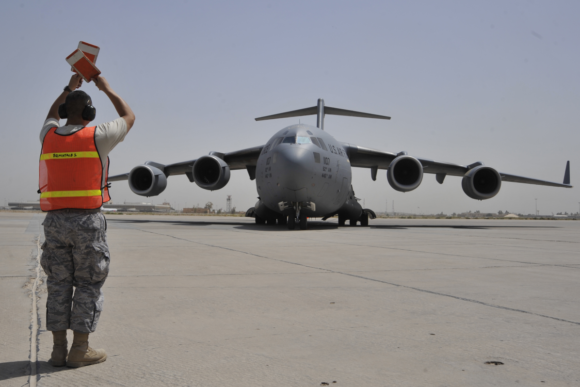Table of Contents
- What Are Space-A Flights (AKA, Military Hops)?
- Are You Eligible for a Space-A Flight?
- How Does Space-A Travel Work?
- 1. Identify Your Destination and Possible Routes
- 2. Follow the Space-A Flight Schedules of the Passenger Terminals You May Use
- 3. Sign Up to Travel from All Possible Starting Locations
- 4. Mark Yourself Present Within 24 Hours of Roll Call
- 5. Listen for Your Name During Roll Call
- 6. Check Your Luggage and Obtain Your Boarding Pass
- 7. Board the Aircraft and Pick Your Seat
- What to Expect on a Space-A Flight
- Pros and Cons of Flying Space-A
- The Pros: What Are the Advantages of Flying Space-A?
- The Cons: What Are the Disadvantages of Space-A?
- When Should You Use Space-A?
- What Would a Seasoned Space-A Traveler Recommend?
Update: On April 22, 2022, the Office of the Under Secretary of Defense lifted all restrictions on Space-A travel. These restrictions were put in place in March 2020 to limit the spread of Covid-19. Mask mandates and medical screening protocols may still apply.
Looking for a way to save money on travel? Flying space-available (Space-A) on a military flight can be a fun and inexpensive way to see the world, as airfare to and from U.S. military bases can cost you next to nothing.
Flying Space-A on military aircraft is very different from using commercial air travel, and you can’t just call a military passenger terminal and book your flight. It’s worth learning how Space-A travel works so you can take advantage of this incredible privilege available to eligible members of the military community.
What Are Space-A Flights (AKA, Military Hops)?
After military flights accommodate all required passengers and cargo, they often release extra seats to service members, retirees and their families. These eligible passengers can “hop” on the flights on a space-available (Space-A) basis. This is where the term “military hop” comes from.
Because these are military, not commercial, flights, the military mission is always the priority. You may fly on a commercial plane, but you could also be in a cargo plane or fuel tanker.
Are You Eligible for a Space-A Flight?
There are six categories, or “cats,” of eligible Space-A travelers, depending on their duty status and the reason they are traveling.
Those in lower-numbered categories receive higher priority for available seats.
Here is a summary of the Space-A travel categories, according to the Military OneSource website:
Cat 1: Emergency leave unfunded travel
Cat 2: Accompanied environmental and morale leave (EML)
Cat 3: Ordinary leave, service members’ relatives, house-hunting permissive temporary duty (TDY), Medal of Honor holders, and foreign military; also includes unaccompanied dependents of service members deployed for more than 365 consecutive days.
Cat 4: Unaccompanied EML; also includes dependents of service members deployed between 30 and 364 consecutive days
Cat 5: Permissive TDY (non-house-hunting), student travel, and post-deployment/mobilization respite absence; also includes unaccompanied dependents of service members stationed outside the continental U.S. (OCONUS)
Cat 6: Military retirees, their dependents, military reserve, Reserve Officers’ Training Corps (ROTC) members and veterans who are 100% disabled
It is important to know your category when planning your Space-A travel because your category determines when you can sign up, what paperwork you need, and where you are eligible to fly. Table 3 in Section 4.11 of Department of Defense Instruction 4515.13 has more details on eligibility by category and approved geographical travel segments.
Eligibility Note for Veterans with a 100% Disability Rating:
According to the AF.mil website, “veterans with a service-connected, permanent disability rating of 100 percent will be able to travel in the Continental United States or directly between the CONUS and Alaska, Hawaii, Puerto Rico, the U.S. Virgin Islands, Guam, and American Samoa (Guam and American Samoa travelers may transit Hawaii or Alaska); or traveling within Alaska, Hawaii, Puerto Rico, or the U.S. Virgin Islands on flights operated by Air Mobility Command.”
Disabled veterans must have a DD Form 2765, Defense Department ID Card (Tan), to fly Space-A.
How Does Space-A Travel Work?
The better you understand how to fly Space-A, the greater your chances of having a successful trip.
1. Identify Your Destination and Possible Routes
1. Identify Your Destination and Possible Routes
The first step is to learn which bases have regular flights to where you want to travel. This list of worldwide destinations where Space-A travel may be available includes profiles of some of the terminals and information about typical flight destinations. You’ll want to begin following some of their Space-A flight schedules, which we’ll discuss in the next step.
You may find several possible routes to your desired destination. For example, if you are on the East Coast and want to fly to one of the common destinations, including Spain or Germany, you will likely be able to travel from several nearby bases. Travelers from other parts of the U.S. may need to take two or more hops to get there.
The Space-A Travelers Facebook group can help you put together a flight plan to your destination. You can ask questions and find information about flying to and from specific locations.
You may have to combine Space-A travel with other transportation. For example, you may need to fly or drive to a base with regular Space-A flights to your desired destination. Or you may need to take a train or flight from an overseas base to your final destination.
2. Follow the Space-A Flight Schedules of the Passenger Terminals You May Use
The Air Mobility Command website maintains a list of all the military passenger terminals, as well as their contact info and links to their websites and Facebook pages.
You’ll find a 72-hour flight schedule for most terminals on their Facebook pages or the AMC website. The schedules include trip destinations, the number of Space-A seats and the “roll call” time. The roll call time is when terminal staff announces who has been selected for the flight.
You may also find information about recently departed flights, including how the number of Space-A seats and how many passengers competed for those seats.
Click here for more details on how to read the Space-A schedules on Facebook.
When you monitor the flights that depart from your target passenger over several weeks or months, you’ll notice patterns in the location and frequency of their missions.
3. Sign Up to Travel from All Possible Starting Locations
Determine all the terminals you could depart from to reach your desired destination. You’ll increase your chances of success by signing up to fly from all of them. Signing up is free and takes only a few minutes.
The AMC website details the sign-up options, including the required information. You can sign up through their website, by email or in person at the terminal. You can also use the Take-A-Hop app (which costs $6.99). If you’re signing up for several terminals, email and the Take-A-Hop app are the easiest ways to do so.
The sooner you can sign up, the better, as priority within each category is based on the sign-up date and time. So sign up as early as possible. At most terminals, your sign-up is valid for up to 60 days.
Keep in mind that your category may affect how early you can sign up for Space-A travel. For example, active-duty service members (Cat 3) must be on leave before they can sign up. Those in Cat 3, however, have precedence over those in Cats 4 through 6, regardless of when they signed up.
4. Mark Yourself Present Within 24 Hours of Roll Call
You must mark yourself present at the terminal before roll call to let the staff know that you are competing for the flight. You can do so anytime within 24 hours of the scheduled roll call. Note: roll call times can change unexpectedly, so continually monitor the terminal’s 72-hour flight schedule to ensure you get there in time or, better yet, call the terminal to confirm.
Bring your military ID and any necessary documents, such as your passport, your leave form or your EML orders. If you are an unaccompanied dependent, you’ll need a memo from your sponsor’s command. Also bring a copy of your sign-up email as a backup to prove your sign-up date and time.
5. Listen for Your Name During Roll Call
At roll call, terminal staff will announce how many Space-A seats are available for the flight and then the names of the selected passengers, beginning with those in the highest-priority category.
If they call your name, go to the desk and confirm that you and any dependents traveling with you are present. You’ll need to show your military ID and any required paperwork, as well as ID cards for passengers older than 10 years old. For younger passengers, bring their passports or MilConnect printouts that show the Department of Defense ID numbers.
If they don’t call your name, don’t leave the terminal just yet. Sometimes last-minute Space-A seats become available, so stay at the terminal until boarding time.
6. Check Your Luggage and Obtain Your Boarding Pass
Once you and all members of your traveling party, along with all your luggage, must be present when the baggage check begins. This may be right after roll call, or it may be several hours later. You will need to stay in the terminal, as boarding times, like roll call times, can change without notice.
The AMC website’s FAQ page includes detailed information on baggage allowances. Because smaller aircraft may have different weight limits for luggage, it’s best to check ahead of time.
You will generally be allowed to check two pieces of luggage weighing up to 70 lbs each. Similar to many commercial flights, you can also bring one piece of carry-on luggage that fits under your seat or in the overhead compartment. You can usually check car seats and strollers, and they won’t count toward your baggage allowance.
AMC terminals follow the Transportation Security Administration’s baggage screening guidelines, so check their website ahead of time to see what you can bring in your carry-on bag, and what you must put in checked luggage.
Check if meals are available on the flight, as you’ll pay for these when you check your luggage. Some locations offer simple box lunches for a nominal cost.
7. Board the Aircraft and Pick Your Seat
If you are flying Space-A on a Patriot Express flight, your boarding pass will list your assigned seat.
When terminal staff announces boarding, you’ll go through security and wait in a secure area. With most flights, a bus will take you to the aircraft, and you’ll board from the tarmac.
On most Space-A flights, you’ll choose your seat when you board. On Patriot Express flights, your boarding pass will list your assigned seat.
What to Expect on a Space-A Flight
Patriot Express flights offer amenities, including meals and in-flight movies.
Other Space-A flights do not. Snacks and water may be available, but it’s best to be prepared and bring your own.
Seating depends on the type of aircraft. Some have seats that are comparable to commercial airlines. Others have web seating along the sides of the plane. If this is the case, you can stretch out if there’s room.
Patriot Express flights are climate-controlled, but other military aircraft are not. They are often cold or hot, so dress in layers. They can also be loud. The crew usually provides foam earplugs, but it’s a good idea to bring your own.
Pros and Cons of Flying Space-A
There are advantages and disadvantages to Space-A travel.
The Pros: What Are the Advantages of Flying Space-A?
Space-A flights can save you hundreds or thousands of dollars over commercial airlines, which is a clear advantage. The only costs you might incur are a low per-passenger fee on Patriot Express flights, and you may be able to purchase low-cost meals at some terminals that offer meals for purchase.
When you land, you’ll be able to access base resources, including overnight base lodging and the commissary. You may even be able to purchase discount tickets to local events and attractions through the base’s Information, Tickets and Travel office (ITT).
Being able to stretch out on some aircraft can be another advantage over flying economy in a commercial plane.
If you’re traveling with small children, you may also find that other passengers are more supportive than with a commercial airline.
And, of course, there may be a greater sense of adventure with Space-A travel.
- Free or low-cost air travel
- Access to base amenities (Base Exchange, Commissary, MWR, ITT, etc.)
- Possibly more space to spread out compared to commercial airlines
- It’s an adventure!
The Cons: What Are the Disadvantages of Space-A?
Space-A travel is less predictable than flying commercially. Passenger terminals post flight schedules only 72 hours in advance, and you won’t know if you got a seat until the last minute.
Peak travel times, including summer, winter holidays, and even spring break, are even more competitive. You may need to be more flexible about when you travel and even where you’ll go.
You may incur other costs with Space-A travel, such as transportation to the base you’ll be flying from. You may need to wait for a flight home–possibly for days–and the costs of lodging and meals can quickly add up.
Finally, Space-A travel, unless you’re on a Patriot Express flight, is bare bones. You may find it cold, loud, and uncomfortable.
Cons
- Travel and schedules can vary.
- Seats aren’t guaranteed — you must have flexible travel plans!
- Travel can be difficult during busy times (summer PCS season, holidays, etc.).
- Lodging, meals and transportation costs can add up.
- Military aircraft can be cold and uncomfortable.
When Should You Use Space-A?
If you have the time, flexibility, and patience to wait for a flight, Space-A travel can offer you an adventure while saving you a lot of money. If you’re traveling for an event, such as a wedding, and must arrive by a specific time, Space-A is not the best way to travel, especially if it’s during the peak seasons of summer, winter holidays, and spring break.
What Would a Seasoned Space-A Traveler Recommend?
Flying Space-A requires planning, patience, and flexibility. Learn as much as you can about the process, and also research desired destinations and passenger terminals so that you can put together a successful flight plan.
When you are ready to leave, make sure you always have a backup plan and ensure you have enough money to pay for commercial transportation if Space-A doesn’t work out. Also, be prepared for a multi-legged journey–several shorter hops that bring you closer to your destination rather than one long direct flight.




Comments:
About the comments on this site:
These responses are not provided or commissioned by the bank advertiser. Responses have not been reviewed, approved or otherwise endorsed by the bank advertiser. It is not the bank advertiser’s responsibility to ensure all posts and/or questions are answered.
MAJ Charles M. Lewis says
I am a 100% disabled vet and retirees. I really want to go see Israel. Is there a way to get there via space A?
Ryan Guina says
MAJ Lewis, I am not aware of any direct Space-A flights to Israel. However, you may be able to take Space-A flights to Germany, Spain, or Italy, where you might be able to purchase commercial travel for less than you could if you flew directly from the United States.
Ronald Thom says
I’m a disabled veteran a 100% rating. I’m just a few miles from Pope Army Air Base. I need information to McGuire Air Base. Do you have regular flight there.
Ryan Guina says
Ronald, you will need to contact the Pope air field terminal for more specific information.
Blaine B Philipson says
Can 100 percent disabled veteran fly to Manila in the Philippines?
Ryan Guina says
Blaine, 100% disabled veterans are eligible to fly Space-A, provided they are able-bodied enough to ingress and egress the aircraft without too much assistance. They should, therefore, be eligible to fly to Manila, Philippines, as long as there is an aircraft going there that has Space-Available seats and the veteran is able to get booked on the flight.
Adam Bruno says
Hello can disabled veterans 100% use space A to fly to Germany ?
Ryan Guina says
Adam, according to the AF.mil website, “veterans with a service-connected, permanent disability rating of 100 percent will be able to travel in the Continental United States or directly between the CONUS and Alaska, Hawaii, Puerto Rico, the U.S. Virgin Islands, Guam, and American Samoa (Guam and American Samoa travelers may transit Hawaii or Alaska); or traveling within Alaska, Hawaii, Puerto Rico, or the U.S. Virgin Islands on flights operated by Air Mobility Command.” I recommend contacting your preferred local Passenger Terminal for more information before showing up for a Space-A flight. Thanks!
william parker says
i am a army disabled vet and havent taken a hop yet but am very interest in doing some traveling. please send me some simple instructions on how this all works. i leave in shreveport louisiana, i am about two miles from barksdale afb. do they have flights leaving out of there or where is my closes place to catch a hop. i would like to travel over sees. do i need a passport?. i have my dd214 i am also 100% p&t
5